Smokes hanging on top of the city and inhaled to the inside of the lungs, whether it came from the buzzling road or the cook stoves and fuels inside of our homes, has now been estimated to cause 6.5 million premature death every year—where most of the cases are due to the increase mortality from non-communicable diseases (NCDs) of which are stroke, heart disease, chronic pulmonary disease, lung cancer and acute respiratory infection. Guideline was made by the WHO to assess countries’ level of safe air and the result shows that 80% of the world’s cities have air pollution level reaching over the WHO guideline for safe air. Moreover, data shows that 92% of people worldwide are not breathing safe air—and most of them came from low-and middle income countries.
Air Pollution and Their Relations with Health Outcomes
There are two kinds of air pollution based on the source of the pollutants, of which are the ambient (outdoor) air pollution and the household (indoor) air pollution. Ambient air pollution’s sources came from vehicles, power generation, incineration and industry. Its health effects vary from the increase of hospital admission, emergency unit cases, and the increased risk of premature death due to lung cancer, acute lower respiratory infection, stroke, ischemic heart disease, and chronic obstructive pulmonary disease. Household air pollution, on the other hand, came from the exposure to cooking fires which involve the burning of dung, wood and coal. Exposure to indoor air pollutants may increase risks of respiratory diseases, cancer and eye illnesses; not to mention a higher risk of burns, poisonings, musculoskeletal injuries and accidents of households that rely on polluting fuels and devices.
Pollutants: How It Affects Our Body
Pollutants which are harmful and considered by the WHO as main concern includes: particulate matter (PM), ground-level ozone (O3), nitrogen dioxide (NO2) and Sulphur dioxide (SO2). PM are inhalable molecules composed of sulphate, nitrates, ammonia, black carbon, mineral dust and water. PM with the diameter less than 10 microns (or is known for its abbreviation PM10) pose a greatest risk to health, as they are able to penetrate to the lungs, reach deep to the alveoli, and enter blood stream. Ultrafine particles (with the diameter of one micron or less), pose an even greater health risk as they are able to enter tissues and organs. Chronic exposure to these particles may increase risks in developing cardiovascular and respiratory diseases as well as including lung cancer.
Ground-level ozone, not to be confused with the ozone that lays on the upper atmosphere, is formed by the reaction occurred between sunlight and pollutants such as nitrogen oxides emitted by vehicles and industries. Thus, ozone pollution levels are high during periods of sunny weather. Excessive levels in the air may cause problems in breathing, trigger asthma, and cause lung diseases.
Nitrogen dioxide (NO2), especially at the concentration exceeding 200 μg/m3, is a toxic gas that may cause inflammation to the breathing airways and is an important part in the fraction of PM2.5. Studies shows that exposure to NO2 correlates with the increase of bronchitis symptoms in children with asthma.
Sulfur dioxide (SO2) is a colorless gas with a sharp odor which are emitted from fossil fuel combustion at power generation and industries, as well as vehicles. Arrays of health outcomes, especially those which correlates with the respiratory system such as inflammation of the respiratory tract (which may cause adverse effects from coughing until bronchitis and its susceptible condition to infections) has been recorded. Exposure of SO2 may also causes irritation to the eyes. Studies shown that hospital admissions for cardiac disease and mortality increase in days with higher SO2 levels. When SO2 combine with water, it forms sulphuric acid, the main component of acidic rain.
Reducing Air Pollution and Its Effects
It is now or never—accessing household safe fuels and technologies, prioritising rapid urban transits, walking and cycling and improving waste management are the only way we can help in reducing the emission of air pollution. But remember to always minimize the self-exposure to air pollutants by wearing facemasks while walking on the busy streets especially when level of air pollution is high.
References
- Air pollution [Internet]. World Health Organization. 2017 [cited 23 December 2017]. Available from: http://www.who.int/airpollution/en/
- Laumbach R, Meng Q, Kipen H. What can individuals do to reduce personal health risks from air pollution?. Journal of thoracic disease. 2015 Jan;7(1):96.
Alessa Fahira
Indonesia One Health University Network
Communication and Networking Team
Individual freedom and happiness are not often stated as resume online https://resumecvwriter.com goals of education in today’s public-policy pronouncements.
